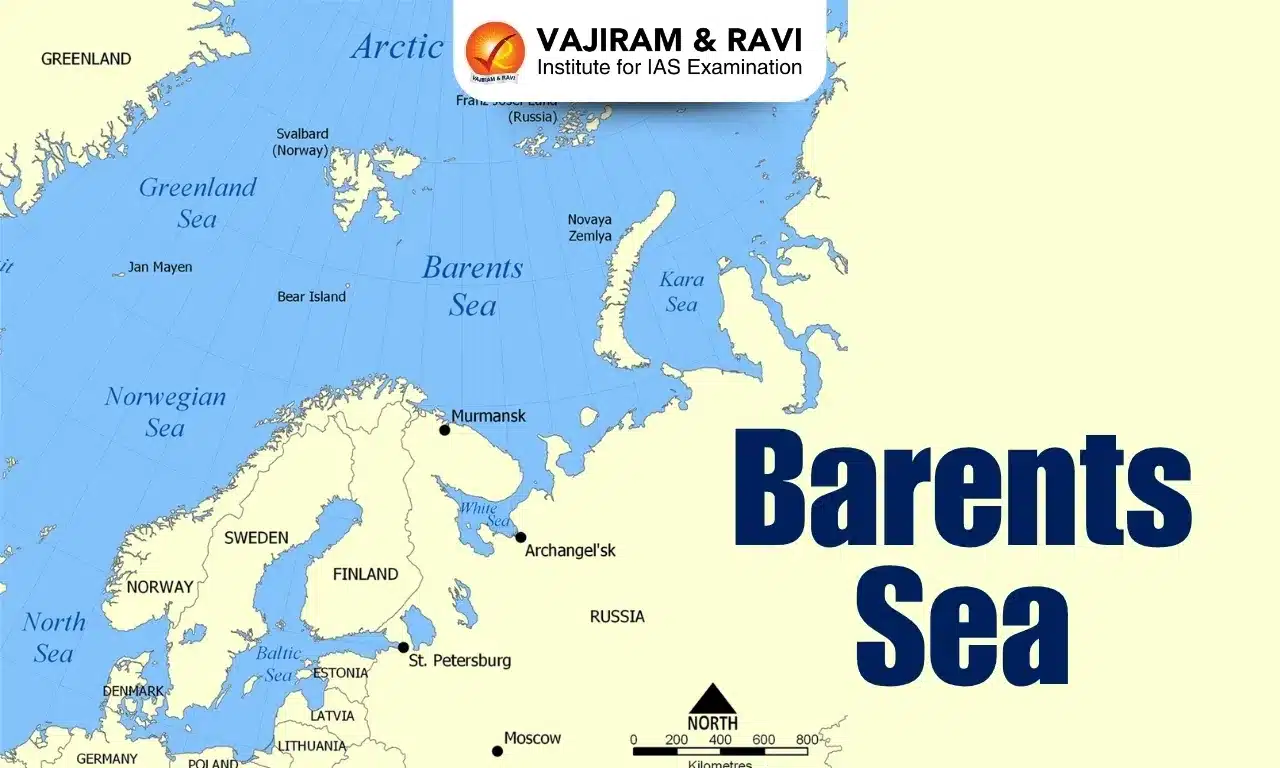Barents Sea Latest News
Russia recently rolled its Bastion coastal defence missile launchers onto the bleak shoreline of the Barents Sea, a dramatic opening move in the navy‑wide exercise codenamed “July Storm.”
About Barents Sea
- It is a marginal sea of the Arctic Ocean located along the northern coasts of Norway and Russia.
- It covers an area of 1.4 million sq.km.
- It was named for Willem Barents, a 16th-century Dutch navigator who explored it while searching for a northeast passage to Asia.
- The sea was known to Vikings and medieval Russians as the Murmean Sea.
- Boundaries:
- It is bounded by the Svalbard archipelago in the northwest, the Franz Josef Land islands in the northeast, the Novaya Zemlya archipelago in the east, the Norwegian Sea and the Greenland Sea in the west, and by the Kola Peninsula in the south.
- It is separated from the Kara Sea by the Kara Strait and the Novaya Zemlya archipelago.
- The White Sea and the Pechora Sea are two parts of the Barents Sea.
- The White Sea is a southern arm of the Barents Sea, which separates the Kola Peninsula from the Russian mainland.
- The Pechora Sea is situated in the southeastern part of the Barents Sea.
- The maximum width of the Barents Sea is 1,050 km, and it is about 1,300 km in length.
- It covers a relatively shallow continental shelf fringing the Eurasian landmass.
- It has an estimated average depth of 230 m.
- The climate of the sea is subarctic.
- The waters of the Barents Sea have a high salinity of 34 parts per 1,000.
- The Gulf Stream keeps the Barents Sea and its adjoining coasts significantly warmer than other sub-Arctic regions.
- It has a rich biological diversity, including some of the world’s most numerous colonies of seabirds such as puffins and guillemots, rich seafloor communities with kelp forests, numerous deepwater coral reefs, and a unique variety of marine mammals such as walrus, bowhead whales, and polar bears.
Source: ET
Last updated on November, 2025
→ Check out the latest UPSC Syllabus 2026 here.
→ Join Vajiram & Ravi’s Interview Guidance Programme for expert help to crack your final UPSC stage.
→ UPSC Mains Result 2025 is now out.
→ UPSC Notification 2026 is scheduled to be released on January 14, 2026.
→ UPSC Calendar 2026 is released on 15th May, 2025.
→ The UPSC Vacancy 2025 were released 1129, out of which 979 were for UPSC CSE and remaining 150 are for UPSC IFoS.
→ UPSC Prelims 2026 will be conducted on 24th May, 2026 & UPSC Mains 2026 will be conducted on 21st August 2026.
→ The UPSC Selection Process is of 3 stages-Prelims, Mains and Interview.
→ UPSC Result 2024 is released with latest UPSC Marksheet 2024. Check Now!
→ UPSC Prelims Result 2025 is out now for the CSE held on 25 May 2025.
→ UPSC Toppers List 2024 is released now. Shakti Dubey is UPSC AIR 1 2024 Topper.
→ UPSC Prelims Question Paper 2025 and Unofficial Prelims Answer Key 2025 are available now.
→ UPSC Mains Question Paper 2025 is out for Essay, GS 1, 2, 3 & GS 4.
→ UPSC Mains Indian Language Question Paper 2025 is now out.
→ UPSC Mains Optional Question Paper 2025 is now out.
→ Also check Best IAS Coaching in Delhi
Barents Sea FAQs
Q1. The Barents Sea is a marginal sea of which ocean?+
Q2. The Barents Sea is located along the northern coasts of which two countries?+
Q3. What was the Barents Sea known as to the Vikings and medieval Russians?+
Q4. What keeps the Barents Sea warmer than other sub-Arctic regions?+
Tags: barents sea prelims pointers upsc current affairs upsc prelims current affairs

















